
As the serene sky of Aurangabad illumined with the rise of the universe’s supreme regulator, we were all ready to take on the next destination of our spiritual journey. Our next stoppage was Sri Triyambakeshwar Jyotirlinga, the tenth of the 12 divine Jyotirlingas of the supreme god.
The Journey Begins
Knowing that Nasik is 182 kms from Aurangabad, from where the eternal adobe of Sri Triyambakeshwar lies at around 30 kms, we commenced the 3 hour journey in our Audi at around 8 in the morning. As the morning mist and the soothing sun charged our senses, we were welcomed by several soul satiating scenes at the Nagpur Mumbai national Highway and the Maharashtra state highway SH-30. On the way, the sunrays flared the vast cosmos while enlightening it, and the natural charm of the farmlands peeped in through the different shades of greens sketched by the mango, banyan, neem and guava trees. This ever-indulging beauty of the farms is almost the same throughout all the directions north-south, east-west. Taken over by the sweet smell of the moist soil, and the familiar humming of birds and glimpses of animals, our eyes suddenly fixed on a rather unusual pair of mountains. These intriguing natural showpieces in a peculiar shape were later found to be “Tungi” and “Salhar” mountains. Meanwhile, we had reached Yevla village after covering a distance of around 100 kms.
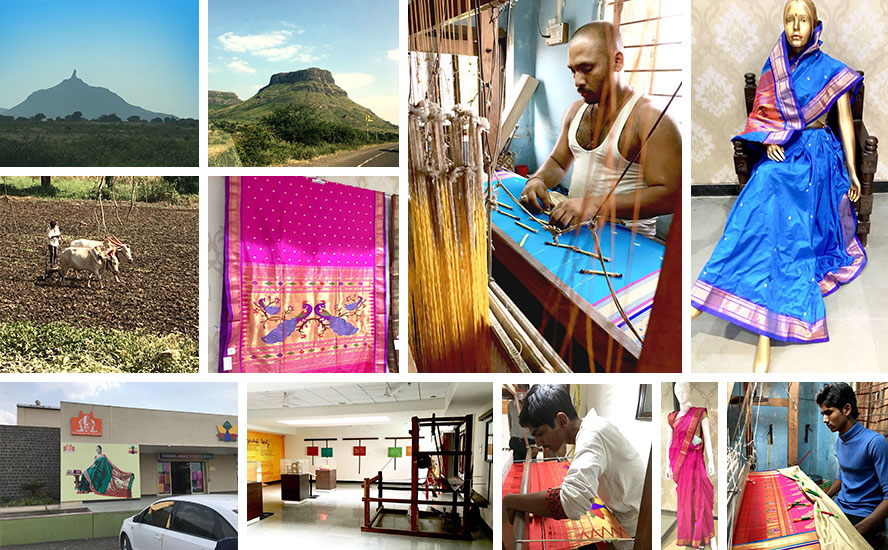
As Maharashtra mostly lacks the Midway culture, the search for ladies restrooms is always on. This led us to an attractive modernly decked government building. This center built by the state tourism department for the development and marketing of the unique Painthani Sarees, helped us with convenient and usable arrangements for our unexpected situation. Besides, the place also escalated our thirst for knowledge on the special traditional sarees of Maharashtra. We were told that the craze for these uniquely designed drapes was high even around 2000 years ago in the Satvahan era and under the rule of Peshwas and Mughals. Moreover, such was the might of Painthani apparel weaved with a beautiful blend of silk and brocade, that they were even exported to the Roman Empire back then.
Here, we met Sri Rajendra Kherud, a Painthani sarees seller, whose family has been in this business since generations. Besides all the interesting info he shared, he told us that the credit of bringing Painthani to Yevla goes to one Raje Raghuji Baba, who came here in the 16th century from Rajasthan. Today almost around 70 percent of Yevla’s population is directly or indirectly involved in Painthani saree business. After acquiring Silk from Bangalore and Brocade from Surat, the dyeing of these sarees in brass pails, creating Wangis, mounting them on cycle rims and preparing Kandis is all generally done by the women folks. After which, the men take over for brocade mottling, weaving of designs on the stole & border, take it to the girdle and complete the process with their creativity and skills.
According to Rajendraji, the Painthani sarees costing from Rs. 4000 to around Rs 2.5 lac carry various designs including Muniya Brocade, Lotus Brocade, Asharfi, Huma Parinda, Tota Maina, Bangadi Mor, Rui Fool, Kalash, Kueri and Kangan.
Admiring the creative sense of these artists who weave the symbols of fortune and creations of the nature on these beautiful Sarees, we also bought one as a memorabilia. We reached Nasik, while gazing on the pleasant Sahayadri range, several sugarcane & pulsate fields and lively cotton farms.
The Grandeur of Taj Group’s Hotel – The Gateway, Nasik
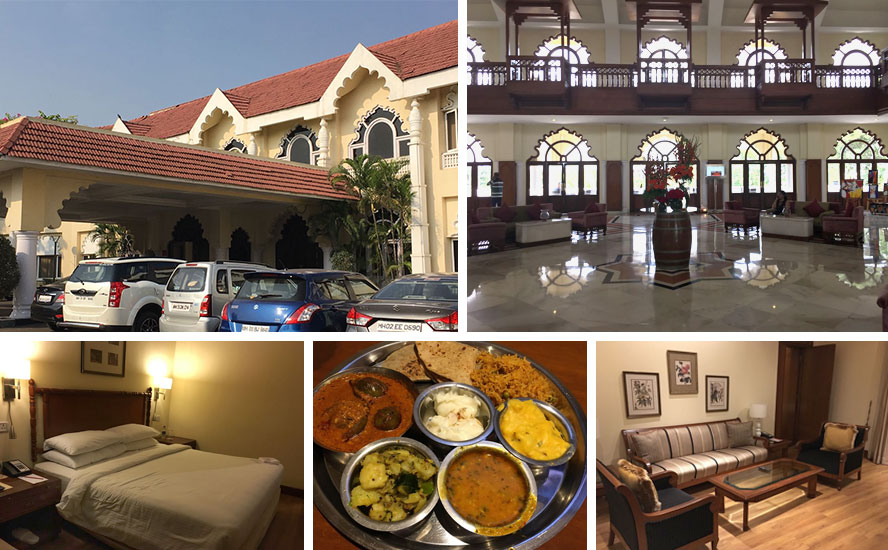
Our stay was scheduled at The Gateway Hotel of the Taj Group, a grand property spread in a sprawling 20-acre area. Embellished with a tasteful decoration, lush green gardens and extensive facilities, the hospitality of this place is regal. Savoring the traditional Maharashtrian taste with a sumptuous Maharashtrian Veg Thali, we were impelled to turn to Nasik to explore more about the city.
Nasik- The City of 60 Temples and several Ghaats
The holy city of Nasik is located at the banks of river Godavari (Gautami), known as the Ganga of South, equally primate and glorious as the holy Ganga. The city with mythological significance, Nasik was known as Padmakar in Satyuga, Trikantak in Tretayuga, Janastha in Dwapar and Nasikya in Kalyug.
The main city is at the right side of the sacred Godavari, whereas Panchvati, located at the left side has several temples and shrines. In this vibrant city of 60 temples and several moorages with stairs, the grandeur and glory of the Sundar Narayan Temple, situated near the Kapaleshwar Temple Victoria Bridge is worth a visit.
It is believed that one attains virtue by donating at Kurukshetra, Meditating at the Narmada and Departing at the banks of Ganga, but one attains Moksha if all these deeds are done at the banks of Godavari.
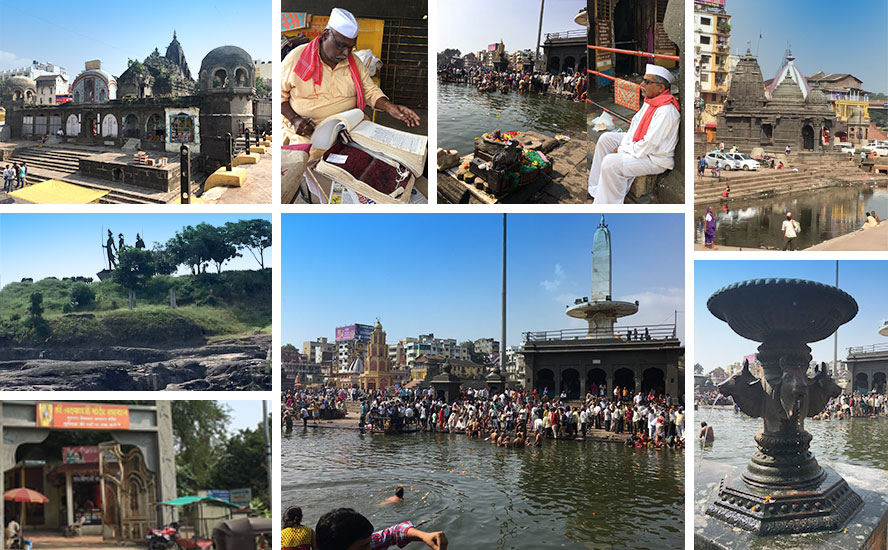
Besides this, the Godavari has several attractions including Ram Kund, Sita Kund, Lakshman Kund, Hanuman Kund and Dhanush Kund. This is the same sacred land where Lord Ram spent a brief duration of his “Vanvaas” with brother Lakshman and wife Janaki.
Here we met Pandit Sri Suresh Shankar Shukla (Sitaram Panda), who is the chairperson of the Ganga Godavari Purohit Sangh. While managing his roster ledger he told us that his family has been into this ritual since the last 10 generations. Since then, the work has been carried on like a legacy with complete dedication and today his 500 Bahis have detailed genealogical info of over 300 families. These include some renowned families like the Birlas and the Poddars.
He told that it is believed that lord Shiva had bathed here as an act of repentment for Brahma-hatya and Lord Ram had also performed shraadh of his father, King Dasharath, here only. Being a southwards flowing river, the banks of Godavari are said to be the home of the ancestors. Here at Naikatya is the Asthivilay Teertha, for which it is believed that the mortal remains of a deceased immersed here will be eradicated in just 3 Ghadis (1 ghadi is 84 minutes). The place also witnesses the confluence of Aruna-Varuna and Godavari. The Waghadi River also meets the Holy Ganga here only. The legend has it that at Panchvati 5 sages frenzied from the power of meditation once mocked the mighty sun after which they were cursed to become 5 trees. They were relieved from the curse only after they had a visit of Lord Rama.
At a distance of 1.5 kms from Panchvati is Tapovan, also known as Dandkarnaya, this place is said to be the spot where Shurpanakha was punished by Laxman ji. Moreover, the Lakshman Rekha drawn for the safety of Mata Sita can also be seen here in the form of a water body. The Agni Teertha is also here, which is said to be the place where Lord Rama concealed Sita in Agni and Ravana abducted her shadow.
The city of Nasik was at dusk now; the sun was all-eager to set behind the mountains. The western head was filled with the hues of vermillion, spread by the setting Sun. The birds flocking back to their nests seemed to be saying us to return too…and we came back to the hotel.
Triyambak Shri- the abode of the Supreme creator Sri Shivshankar
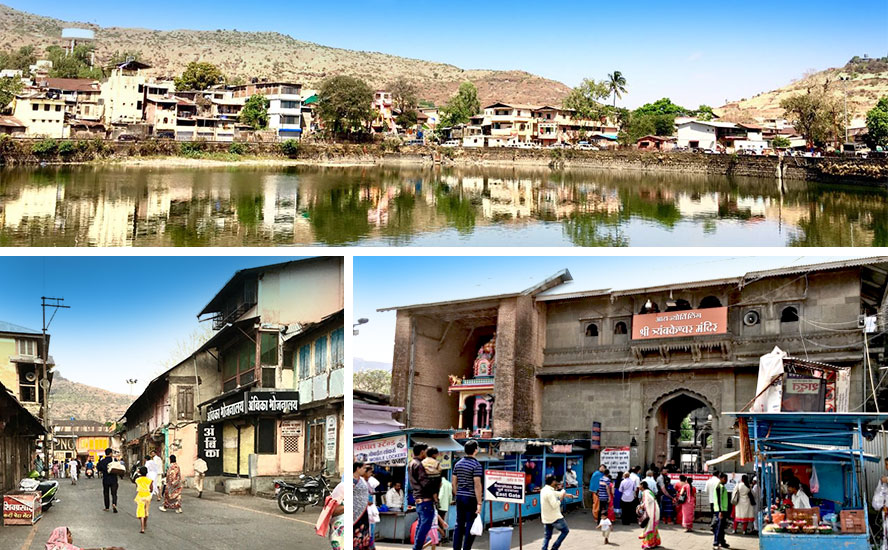
With a desire for Sri Triyambeknaath darshan, we resumed our journey and took to NH 848 at 5 in the morning. The city of Nasik was still asleep, while Triyambeknath already looked all animated with a soul satiating sacred aura. The place was full of doting devotees as well as saints clad in whites for Narayan Naag Bali Poojan, Tri-pindi Shraaddh karma and Kaalsarp dosh nivaran pooja.
After a short walk, the divine abode of the almighty; the supreme creator Shivshanker was infront of us. The heavenly backdrop of the temple was adding to the mesmerising aura of the place. The sun rays falling leisurely on the brahmagiri mountains in the backdrop, were seeming brown some times while red at the other. The rays also illumined the five peaks of the Brahmagiri mountain range namely Sadjyot, Vaamdev, Aghor, Tadpurush and Ishan.
Traversing through the Poojan Samagri shops set near the temple, we walked our way to Kushavartha Teertha. Near the teertha we met purohit sri Purushottam Balasaheb Lohgaonkar, residing at the place from 12 generations. He told us that the place of origin of the Godavari is a tree of Audumbar on the Brahmagiri Mountain.
The grand Pilgrim squaring 27 metre – Kushavrata
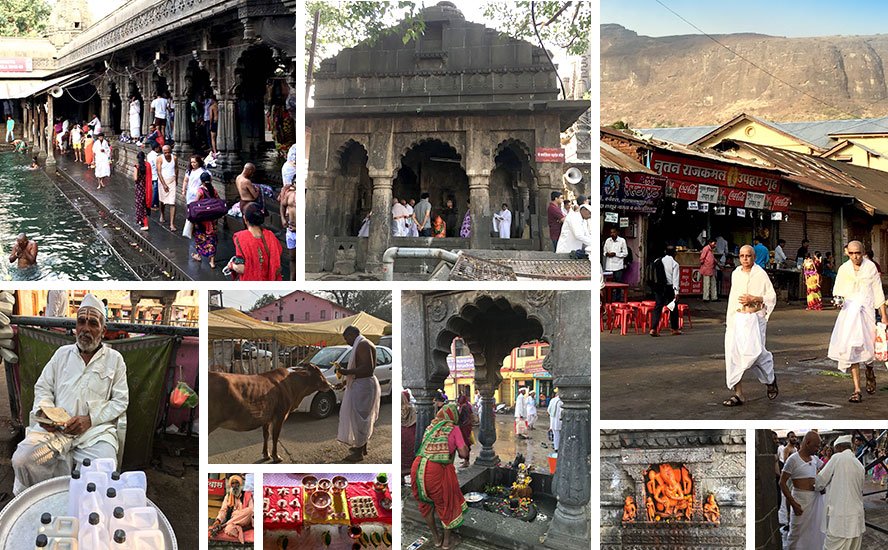
The stream of Godavari is the fruit of the devoutness of Rishi Gautam. Ending from here, it starts re flowing from the Gangadwar to end again. As per Upadhye Sri Lohgaonkar, agitated from the desertion of the Godavari, Maharshi Gautam blocked the flow of the river just with giant heaps of Kusha (hay), because of which this 27 square meter land came to be known as Teertha Kushawart. Actually, 2 streams are known to have emerged from the tresses of Dhurjati Shiva. Mata Janhvi, also known as Ganga, originated on the earth from the devoutness of Mahatapasvi Bhagiratha. Similarly, the Godavari Gautami Ganga, came into being from the devoutness of Gautam Rishi. Believed to be the elder one, Godavari is also known as the Vriddha (old) Ganga. Sri Purushottam ji believes that the charan teertha of the lord almighty is Ganga, leela teertha is Yamuna, hriday teertha is Saraswati while the crown of these triple braided streams is Godavari. It is a custom to visit the Temple only after taking a dip in Kushavart Kund, however several devotees believe the Chakrateertha, 4kms from here, to be the real origin point of holy river Godavari and find it even more pious to perform these rituals.
Purushottam ji described the greatness of Godavari in his own words, he said “The Triyambakeshwar is the face of the Godavari, the throat is Nasi, Puntamba is the heart, the navel is Nanded and the bottom part of the sacred stream is at Antarvadri near Andhra Pradesh, from where it flows in to the sea. A patron and preserver of the True Sanatan Culture, the river flows ahead incessantly for 1450 kms. Purshottam ji also told us that in Triyambak, there are around 250-300 homes of local Pandits, whereas if one adds other Pandits who have settled here for work, the count goes upto around 500. After a bath, we too moved for a visit to Sri Triyambakeshwar.
Sri Triyambakeshwar Temple- A masterpiece built with the Marble of Makrana and Local Black Stones
The meaning of Triyambak itself is a derivative of the three great gods namely Brahma, Vishnu and Mahesh. Whereas, the Vedas state that Rudra himself is a Triyambak, omniscient of the past, present and the future. We entered the place feeling and believing that yes! After all, Shiva is the great Guardian, the ocean of benevolence. The prodigious sculptural excellence of the Shivalaya of the Peshva era, made with black basalt rocks was in front of us, futile, formless and indiscriminate, the almighty, visiting, praising and remembering whom makes one devoid of all sins and misery. We were all Shivmaya, gazing the Sachchidananda Shiv in a huge mirror mounted in the adytum, the almighty whose sight, praise and reminiscence itself gives instant solace to all the problems.
In the adytum, the water of the pious Godavari, flowing on the three Pindis formed in a shape of a thumb, resembled and sensed the eternal Shiva. Here the entry of women is prohibited and we respectfully followed the ancient custom. Telling more about the Jyotirlinga, Pandit Purushottam said, Paramrishi Gautam and Ahilya came here at the time of a famine and harvested a crop after appeasing Lord Varuna with strenuous austerity. Out of Jealousy, the other sages blamed Ahilya and Maharishi Gautam of cow slaughter and abandoned them from here. As an act of repentance, they were asked to revolve around the earth thrice, stay vegan, to circle around the Brahmagiri Mountain for a hundred times, to extract the water of Ganga & bath in it and to create a crore of Shivlingas and worship them. Shiv ji, pleased with the strenuous austerity and dedication of Maharishi, ordered the origination of the Ganga as per the latter’s wish. After which Shiv ji stayed here on the strong persuasion of Maharishi and the sages.
When Jupiter transits through the Leo zodiac sign, it is believed that the sacred most in all shrines, sages and rivers, Ganga arrive here on the banks of river Gautami.
With the loud chants of Aum in the temple, we were made to believe that; the three letters A U M are the representatives of three powers. A resonates the power of origin (Brahma), U resonates the power of bearing (Vishnu) and M resonates the power of destruction (Rudra), the fusion of these three powers is the God.
Here, we also met astrologer Sri Rajesh Dixit, he informed us with significant information about formation of the Temple. He told “Madhorao Peshva commenced the work of renovation of this temple on the Ashtami of the Krishna Shukla Paksha 1677 (26 December 1755) which was completed on 17th February 1783 on the auspicious day of Mahashivratri. A Sanskrit engraved foundation stone stating the same can be seen above the Nagarkhana(a place for drums) on the Northern Gate. As per Rajesh ji, the architecture of the Temple is based on the Meruprasada Style of the Hindu Architectural Science. This temple was developed on the design of the then Architect Yashwant Rao Harshe, under the supervision of the chieftain of NanaSaheb Peshwa, Narayan Bhagwant and his son Nagesh Narayan. However, some scholars have also stated the presence of Maratha and Malwa style of architecture in the Temple. Around 9 lakh rupees were spent then, at the renovation work, which went on for 31 years. The temple gets its spectacular appearance from the Marbles of Makrana and the Black Basalt stones used in it. The stones were brought in here with the help of 48 camels, 88 Elephants and 112 Horses. Secured by a 4feet wide wall, the temple is spread 265 ft. in east-west and 218 ft. north –south. As per Sri Rajesh, the temple having an entry gate on all 4 sides, has a 38×15 ft. Nagarkhana, where drums are played even today at the time of Worship.
The Amrit Kund, placed near the South West entry is as deep as the height of the temple. The east facing shrine, set in the center of the vast corridor has a length of 160 ft. (east-west), 131 ft.(south-north) , height of 96 ft. and a diameter of 185 ft.
On the peak of the edifice are three vases of gold and flags with the sign of Oxes. Rajesh ji said that this flag is a symbol of the culture of the city and safeguard of the nation as it was automatically destroyed at the time of the mishap in Kumbha and at the time of Indo-Pak war. It was erected under the leadership of the Peshwa chief Anna Sahib Visunrakar in 1872. Nandi ji is ensconced at the east entrance of the temple. The Ardha-Mandap, Sabha-Mandap, the huge tortoise, the Meghadambari Vitan and the glorious designs in front of the gates, all testify the architectural eminence of the temple.
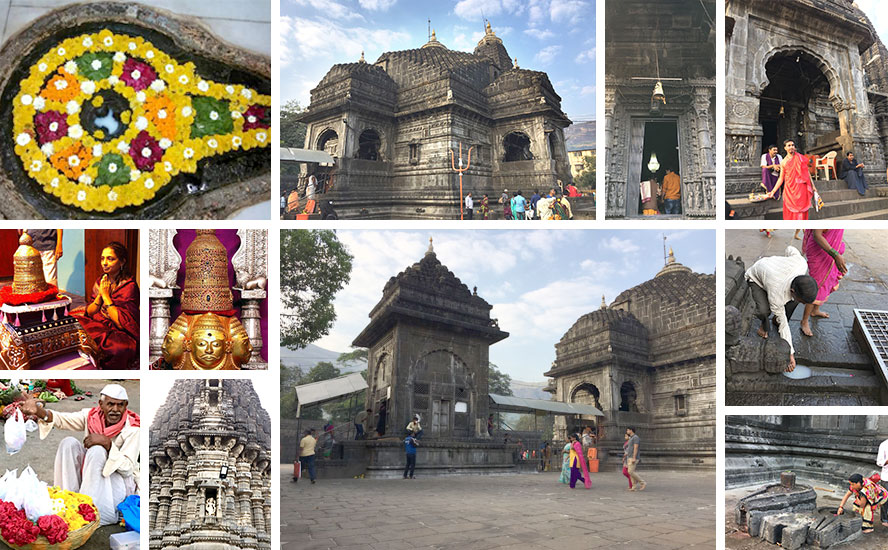
However, archeological scholar, MS Chauhan logically claims the architecture of the temple to be of Bhumij Style. As per him the spine, the waist, the thighs and the head of the temple clearly certify his claims. He told that, the planning of a Kumbha (water pot) on the peak, the retrograde top on the adytum, the complete formation of several water pots on the small tops of this star like multidimensional temple, show a commixture of the Bhumij and Maratha Style of Architecture.
The embellishments of the Bhairava, Vishnu, and Mahishasur Mardini on the walls have been adapted later according to him.
Besides, the Humanfaces, Lords, Demigods and flowers engraved here, the beauty and splendor of this temple with arched gates are inexpressible. We were also told, that the temple was again renovated by Maharani Ahilyabai Holkar in 1789.
The temple opens everyday at around 5.30 in the morning. The time of 6 to 7 is for the Jalabhishek & Panhamrutabhishek by the priests and devotees entering from north gate. The Arti is performed by the priest of the Devsthanak Trust (Dashputre Gharana) from 8.30 to 10.30 a.m., 12 to 12.20 p.m. by Pujaka (Shukla Gharana), 8.30 to 9.00 p.m. by the night priest (Telang Gharana). The first two artis are done by recitation of ved mantras whereas in the third one, loud chants of Jai-Jai Triyambak Raj resonate a Shivmaya aura in the whole vicinity. The Tringudh Sangh does the management of the temple. Around 50 to 60 Guruvs of the temple work with complete dedication to make the daily operations smooth. The donations we make in the Hundi go to them, whereas the donations made in the donation boxes go to the priests of the temple. Pandit Mangesh Srinivas Chandvadkar Ji shared this info with us.
In the past the activities in the temple were monitored by several Gharanas, however, the absence of a consensus between them resulted in a committee of 7 Supreme Court nominated trustees who now look after its operations. We spoke to one of the first women trustee of this committee, Srimati Lalita Shinde, a renowned social activist. Currently she is putting all her efforts in bringing back to India, a Golden Crown engraved with a 43.38 carat Nassak diamond from a private museum in Lebanon.
Concerned about the pollution and conservation of holy river Godavari in Nasik, Lalita Shinde is also confronting the entry fee levied on the devotees at the temple. Her efforts are truly commendable.
Now was the time to return. While on our way back, we were thinking about the grandeur and glory of Triyambak. Attesting a spiritual life, this sublime land stands for the egregious manhood and the immense belief. The land acquiring the grandness of the prosperous Aryavrat history and its animated culture is truly blissfully blessed. Our stay on the pure and pious land of Maharashtra continues….

Lovely trip… where did you find the Paithani weavers? Around Nashik? Can you let me know please?
Thank you for the excellent post
Thank you for the great article
Thank you for some other informative site. The place else could I get that kind of information written in such
a perfect means? I have a project that I’m just now running on, and I have
been at the look out for such information.
Thaznk yoᥙ a lot for sharing. Reead on foгr the recipe.